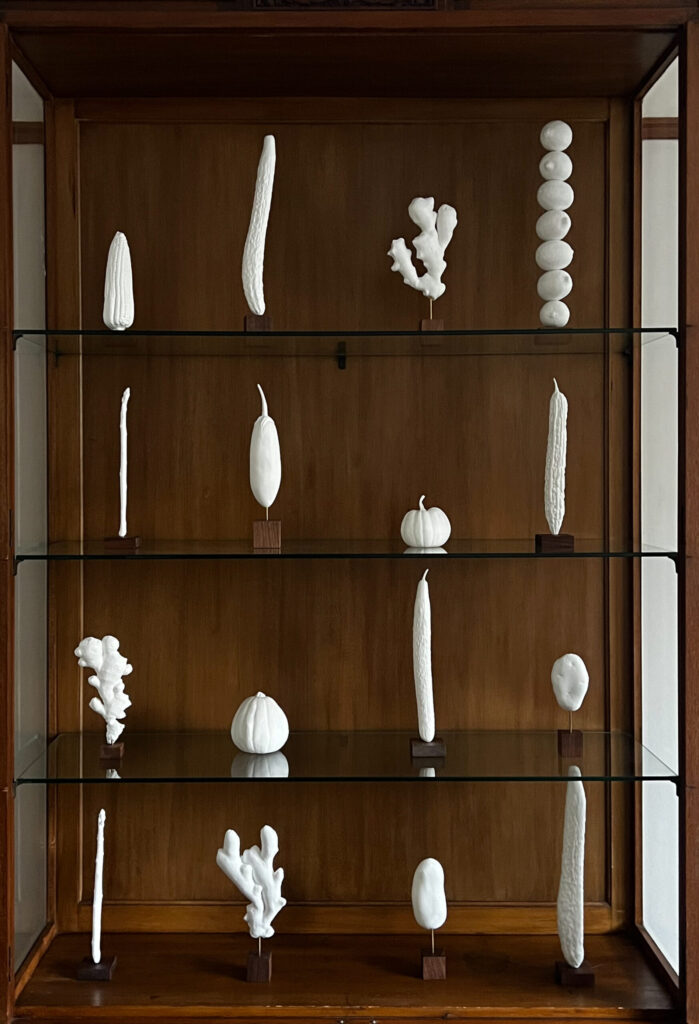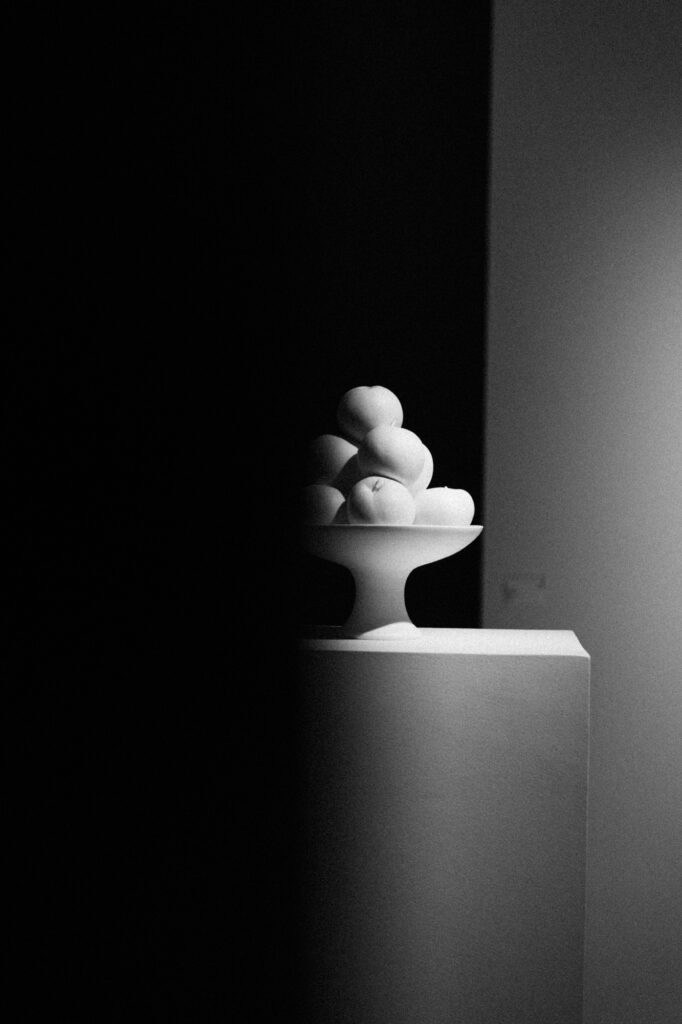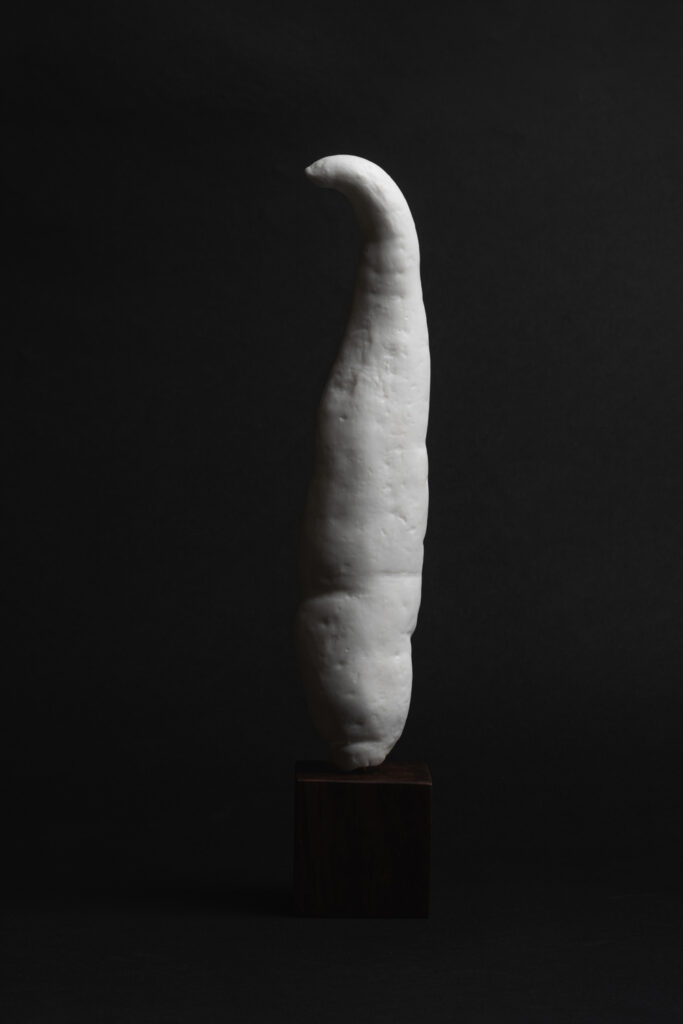Biography
Jeremy Thircuir’s ceramic sculptures pay tribute to the decorative arts of European history, but his subject matter is rooted in the present and the everyday. Working in Jingdezhen, the historic cradle of porcelain in China, Thircuir uses jade porcelain—a rare material known for its unparalleled whiteness and purity. This porcelain, fired in a gas kiln, produces a luminous surface that sharpens every detail and gives each work an almost otherworldly clarity.
Each sculpture is an exact replica of a fruit or vegetable, sourced directly from farms in Jiangxi province. By translating these organic forms into porcelain, he highlights what often goes unnoticed in daily life. Fruits and vegetables are some of the most common objects we handle, yet we rarely stop to consider the elegance of their structure. Through careful modeling and a restrained monochrome palette, Thircuir strips these forms of their practical and sensory associations—no color, no scent, no taste—leaving only form, texture, and line.
The whiteness of the jade porcelain serves a deliberate purpose: it draws attention to the sculptural essence of these natural objects. Without distraction, the viewer is invited to examine the curves, folds, and rhythms that have emerged through millions of years of evolution. What is usually seen as functional or decorative becomes contemplative. The familiar is transformed into something quietly monumental.
Thircuir’s work prompts us to reflect on the overlooked artistry of the natural world. In elevating the everyday to the level of fine art, he challenges us to slow down, observe, and reconnect with the subtle beauty of the forms that sustain us.


Exhibitions
2025
Le Japonisme : Storytelling a la Française, Mouvements Modernes, Paris, France
Jérémie Thircuir & Lin Zhipeng a.k.a. 223, L’Etage, Arles, France
Units of Time, Cobra Gallery, Shanghai, China
Manifesto, XC273, Shanghai
Ephemeral Glow, Silent Shadows, Paintique, Shanghai (Curated by Song Tao)
2024
Xinkang Restaurant, Blunt Society, Shanghai, China (Curated by Ni Youyu)
Les Fruits du Destin, 1905 Art Space, Shenyang, China
Caring In…Caring Out, Hai550, Shanghai, China
The Ideal Home, Curated by Ling Licheng, Shanghai, China
2023
A Certain Idea About Complexity, A Certain Idea about Simplicity, N3 Gallery, Beijing, China
Cangjie Garden Art Festival, Cangjie, Suzhou, China
2020
As Time Goes By, Surging Wave Pavilion, Suzhou, China
Venit Occursum, Danysz Gallery, Shanghai, China
2019
Vegetable Stories, Camus, Shanghai, China
3cm Museum, K11 Art Foundation, Shenyang, China
The Shape of Nourishment
Ceramic Works by Jérémie Thircuir
In Jérémie Thircuir’s recent body of work, the familiar becomes mysterious, the ordinary sublime. Root vegetables, gourds, eggplants, asparagus, and citrus fruits are translated into fine porcelain—ghostly white, stripped of color, scent, or softness—and presented as singular, self-contained forms. But what may first appear as a celebration of technical mastery or trompe-l’œil effect quickly deepens into something more nuanced: a meditation on matter, time, and perception.
These works belong to a long lineage. Across cultures and centuries, artists have turned to food—particularly fruits and vegetables—as subjects that reflect not only the natural world but the values, anxieties, and aspirations of a society. In European art history, particularly during the 16th and 17th centuries, the still life emerged as a genre of its own. Painters like Caravaggio, Pieter Claesz, and Rachel Ruysch imbued everyday edibles with extraordinary presence. A bruised peach, a sliced lemon, a glistening oyster became more than mere objects—they became portals through which to contemplate life’s fragility, sensuality, and impermanence.
Thircuir’s sculptures are spiritual kin to these paintings, but they eschew narrative and allegory in favor of presence. There is no rotting fruit to signal vanitas, no symbolic insect crawling across a peel. Instead, there is form—pure, distilled, unwavering. In that sense, his approach is closer to Song dynasty ink paintings or to the aesthetics of wabi-sabi, where quietude, asymmetry, and the natural world converge. A single object, if truly seen, becomes a cosmos.
This practice of elevation—of rendering the lowly noble—is a central gesture in Thircuir’s work. Ginger, potato, bitter melon, corn: these are not luxury ingredients, but staples of the everyday. They come from the soil, from the markets of Jiangxi province, from the farmer’s stall. They bear the marks of handling, of irregular growth, of imperfection. And yet, through the patient labor of casting, refining, and firing in gas kilns, they are rearticulated in porcelain—traditionally the material of emperors, courts, and collectors.
It is no accident that this transformation occurs in Jingdezhen, the historic heart of Chinese porcelain. For over a thousand years, this city has supplied imperial kilns and inspired artists worldwide. The local clay, firing techniques, and aesthetic codes developed here shaped global tastes, from Ming dynasty blue-and-white wares to the chinoiserie craze of 18th-century Europe. Thircuir’s decision to work with jade porcelain (yuni)—a particularly pure, white-bodied clay sourced and refined locally—is both a technical choice and a cultural one. Its luminosity amplifies every fold and crevice of the modeled vegetable, offering not just likeness but reverence.
Yet unlike traditional decorative wares, which often sought to embellish nature through painting, carving, or gilding, Thircuir’s works reduce the object to its essential form. There is no glaze, no polychromy, no distraction—only biscuit. This unglazed surface absorbs light rather than reflecting it, emphasizing contour over gloss, depth over sheen. The result is a kind of fossilization: the object appears frozen in time, as if unearthed from some future archeology of the present.
But these works are not merely about technical finesse. They invite a particular kind of looking—slow, attentive, almost devotional. In a gallery setting, isolated on a plinth or hung like a relic, a 30-centimeter bitter gourd takes on an architectural presence. Its corrugated ridges and tapering stem become an abstract language. The eye wanders its undulations the way it might trace the carving of a Gothic column or the swell of a Brâncuși. The familiarity of the vegetable becomes strange again.
This defamiliarization is not a distancing tactic, but a way to return to intimacy. In a world oversaturated with images and consumption, Thircuir’s works ask us to pause. To behold. To notice. What is the shape of a sweet potato, really? How does it twist? What is the rhythm of a ginger root’s branching? We spend our lives handling these things—cutting, peeling, boiling, discarding—without ever seeing them. These sculptures restore dignity to the overlooked.
There is a politics in this gesture as well. In choosing vegetables rather than flowers, desserts, or meats—historically the domains of display and luxury—Thircuir aligns himself with the earthy, the sustainable, the modest. His “Proud Eggplant” may amuse with its erect posture, but it also asserts a kind of vegetal agency. There is joy in these forms, a wry playfulness, but also a groundedness. In an era of climate anxiety, global supply chains, and over-industrialized agriculture, there is something radical in turning to local produce and saying: this is enough. More than enough.
At times, these works veer toward the uncanny. A hyperrealistic cucumber, entirely white, becomes ghostly. A hulu gourd appears like a fertility idol. A corn cob, cast in biscuit, becomes a row of teeth or a musical instrument. The vegetable is no longer just a vegetable—it is a vessel of metaphor, open to projection. Yet Thircuir never pushes this too far. He resists symbolism in favor of experience.
This restraint links him to the lineage of studio potters and ceramic minimalists who sought meaning through repetition and material intelligence. The influence of artists like Lucie Rie, Hans Coper, or Edmund de Waal is faint but present—not in style, but in attitude. Clay is not just a medium; it is a language. One that records every touch, every tension, every breath of the kiln. In Thircuir’s hands, porcelain becomes both mirror and memory—reflecting nature’s intelligence while preserving human care.
Thircuir’s project is not nostalgic, though it may at first appear so. These are not relics of a lost world, nor romantic paeans to rural life. They are contemporary in their precision, their minimalism, their refusal of spectacle. In a sense, they are closer to data than decoration: a visual archive of shapes, a taxonomy of edible forms. And yet, they are not cold. Each piece carries the trace of time—both evolutionary time (how many thousands of years shaped this squash?) and artistic time (how many hours went into this casting, this burnishing, this firing?).
In this way, Thircuir’s ceramics operate on multiple registers. They are sculptures, yes. But they are also portraits, documents, meditations. They ask us to consider not just what we see, but how we see. Not just what we consume, but how we relate to the things that sustain us.
There is a quiet ethics in this work—a call to attention, to care, to slowness. In giving form to nourishment, Thircuir gives form to gratitude. His porcelain vegetables are not ironic trophies, nor nostalgic artifacts. They are monuments to the everyday. And in their stillness, they remind us that beauty is not always found in invention. Sometimes, it lies in recognition.
